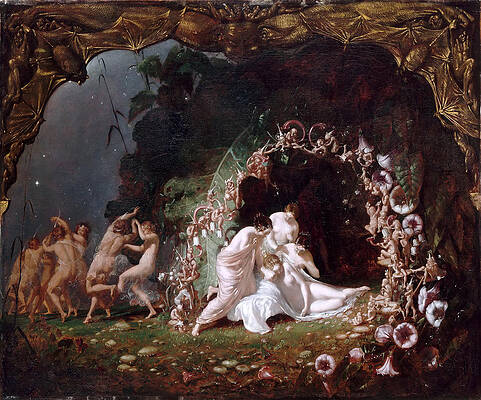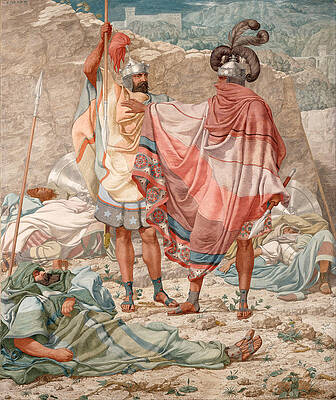Richard Dadd
Paintings
Titania Sleeping
Fish Market by the Sea
Caravanserai at Mylasa in Asia Minor
Augustus Egg
Hamlet and his Mother, The Closet Scene
Puck
Mercy. David Spareth Saul's Life

The Fairy-Feller's Master-Stroke ,

Come unto These Yellow Sands ,

Contradiction: Oberon and Titania ,


Sketch to Illustrate the Passions-Ambition
Portrait of Mr. George Bailey
Sketch to Illustrate the Passions-Ambition
Fine Art Prints | Greeting Cards | Phone Cases | Lifestyle | Face Masks | Men's , Women' Apparel | Home Decor | jigsaw puzzles | Notebooks | Tapestries | ...
Richard Dadd (1 August 1817 – 7 January 1886) was an English painter of the Victorian era, noted for his depictions of fairies and other supernatural subjects, Orientalist scenes, and enigmatic genre scenes, rendered with obsessively minuscule detail. Most of the works for which he is best known were created while he was incarcerated in a psychiatric hospital.
Early life
Dadd was born at Chatham, Kent, England, the son of a chemist. He was educated at King's School, Rochester where his aptitude for drawing was evident at an early age, leading to his admission to the Royal Academy of Arts at the age of 20. He was awarded the medal for life drawing in 1840.[1] With William Powell Frith, Augustus Egg, Henry O'Neil and others, he founded The Clique, of which he was generally considered the leading talent.[2] He was also trained at William Dadson's Academy of Art.[1]
Career
Caravanserai at Mylasa in Asia Minor, 1845, Yale Cantre for British Art
Among his best-known early works are the illustrations he produced for The Book of British Ballads (1842), and a frontispiece he designed for The Kentish Coronal (1840).[1]
In July 1842, Sir Thomas Phillips, the former mayor of Newport, chose Dadd to accompany him as his draftsman on an expedition through Europe to Greece, Turkey, Southern Syria and finally Egypt. In November of that year they spent a gruelling two weeks in Southern Syria, passing from Jerusalem to Jordan and returning across the Engaddi wilderness. Toward the end of December, while traveling up the Nile by boat, Dadd underwent a dramatic personality change, becoming delusional, increasingly violent, and believing himself to be under the influence of the Egyptian god Osiris. His condition was initially thought to be sunstroke.[3]
Madness and incarceration
The Fairy Feller's Master-Stroke, oil on canvas, 26 inches x 21 inches, 1855–64, Tate Gallery, London.
On his return in the spring of 1843, he was diagnosed to be of unsound mind and was taken by his family to recuperate in the countryside village of Cobham, Kent. In August of that year, having become convinced that his father was the Devil in disguise, Dadd killed him with a knife and fled to France.[4] En route to Paris, Dadd attempted to kill another tourist with a razor but was overpowered and arrested by police. Dadd confessed to killing his father and was returned to England, where he was committed to the criminal department of Bethlem psychiatric hospital (also known as Bedlam). Here and subsequently at the newly-created Broadmoor Hospital, Dadd was cared for (and encouraged to continue painting) in an enlightened manner by Drs William Wood, William Orange and Sir W. Charles Hood.[5]
Dadd probably suffered from a form of paranoid schizophrenia.[6] Two of his siblings were similarly afflicted, while a third had "a private attendant" for unknown reasons.[3]
In the hospital he was allowed to continue to paint, and it was here that many of his masterpieces were created, including his most celebrated painting, The Fairy Feller's Master-Stroke, which he worked on between 1855 and 1864. Also dating from the 1850s are the 33 watercolour drawings titled Sketches to Illustrate the Passions, which include Grief or Sorrow, Love, and Jealousy, as well as Agony-Raving Madness and Murder. Like most of his works these are executed on a small scale and feature protagonists whose eyes are fixed in a peculiar, unfocused stare. Dadd also produced many shipping scenes and landscapes during his incarceration, such as the ethereal 1861 watercolour Port Stragglin. These are executed with a miniaturist's eye for detail which belie the fact that they are products of imagination and memory.[7]
Death
After 20 years at Bethlem, Dadd was moved to Broadmoor Hospital, a psychiatric facility outside London. Here he remained, painting constantly and receiving infrequent visitors until 7 January 1886, when he died "from an extensive disease of the lungs".[8]
Legacy
The Fairy Feller's Master-Stroke inspired a song of the same name by the British rock band Queen. The painting also is a plot element in The Witches of Chiswick by Robert Rankin. The Wee Free Men, a novel by Terry Pratchett, published in 2003, was partly inspired by it as well. The Hum and the Shiver by Alex Bledsoe includes references to a lost version of the painting. The painting and the artist are also referenced in Elizabeth Hand's novel Mortal Love.
The British fantasy writer Angela Carter wrote Come unto these Yellow Sands, a radio-play based on Dadd's life.
The full name of the eccentric character Mr. Dick in David Copperfield by Charles Dickens is Richard Babley, which echoes the name of Dickens' contemporary Richard Dadd.[9] Canadian author R.J. Anderson acknowledges Dadd as the basis of her fictional painter Alfred Wrenfield, who figures prominently in her young adult fantasy novel Knife (Faery Rebels: Spell Hunter in the USA).[10]
In 1987 a long-lost watercolour by Dadd, The Artist's Halt in the Desert, was discovered by Peter Nahum on the BBC TV programme Antiques Roadshow. Made while the artist was incarcerated, it is based on sketches made during his tour of the Middle East, and shows his party encamped by the Dead Sea, with Dadd at the far right.[11] It was later sold for £100,000 to the British Museum.[12]
See also
Fairy painting
Notes
Souter 2012, p. 23
Allderidge 1974, Richard Dadd, p. 13.
Allderidge 1974, Richard Dadd, p. 22.
Allderidge 1974, Richard Dadd, p. 24.
Chaney 2006
The Victorians part 4. Dreams and Nightmares BBC One, 8 March 2009
Allderidge 1974, Richard Dadd, pp. 31–33.
Greysmith 1973, p. 73.
2003 Barnes and Noble Classics edition of David Copperfield, with Notes by Radhika Jones.
McNeil, Gretchen (2009, 10 June). [Interview with R.J. Anderson]. The Enchanted Inkpot. Retrieved 1 December 2009, from web site: http://community.livejournal.com/enchantedinkpot/15627.html
(http://www.leicestergalleries.com/art-and-antiques/detail/11795)
"Richard Dadd, The Halt in the Desert, a watercolour". Explore/Highlights. The British Museum. Retrieved February 28, 2014.
References
Allderidge, Patricia (1974). Richard Dadd. New York and London: St. Martin's Press/Academy Editions.
Allderidge, Patricia (1974). The Late Richard Dadd 1817–1886. London: The Tate Gallery.
Chaney, Edward (2006). 'Egypt in England and America: The Cultural Memorials of Religion, Royalty and Religion', Sites of Exchange: European Crossroads and Faultlines, eds. M. Ascari and A. Corrado. Amsterdam and New York: Rodopi.
Chaney, Edward (2006b). 'Freudian Egypt', The London Magazine (April/May 2006), pp. 62–69.
Greysmith, David (1973). Richard Dadd: The Rock and Castle of Seclusion. New York: Macmillan Publishing Co., Inc.
Souter, Nick and Tessa (2012). The Illustration Handbook: A guide to the world's greatest illustrators. Oceana. ISBN 9781845734732.
Tromans, Nicholas (2011). Richard Dadd: the Artist and the Asylum.
---
Fine Art Prints | Greeting Cards | Phone Cases | Lifestyle | Face Masks | Men's , Women' Apparel | Home Decor | jigsaw puzzles | Notebooks | Tapestries | ...
---
Artist
A - B - C - D - E - F - G - H - I - J - K - L - M -
N - O - P - Q - R - S - T - U - V - W - X - Y - Z
Retrieved from "http://en.wikipedia.org/"
All text is available under the terms of the GNU Free Documentation License












